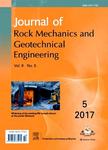New artificial neural networks for true triaxial stress state analysis and demonstration of intermediate principal stress effects on intact rock strength
New artificial neural networks for true triaxial stress state analysis and demonstration of intermediate principal stress effects on intact rock strength作者机构:Mining Engineering Department Colorado School of Mines Golden CO USA
出 版 物:《Journal of Rock Mechanics and Geotechnical Engineering》 (岩石力学与岩土工程学报(英文版))
年 卷 期:2014年第6卷第4期
页 面:338-347页
核心收录:
学科分类:08[工学] 080104[工学-工程力学] 0815[工学-水利工程] 0801[工学-力学(可授工学、理学学位)]
主 题:Artificial neural networks Polyaxial loading Intermediate principal stress Rock failure criteria True triaxial test
摘 要:Simulations are conducted using five new artificial neural networks developed herein to demonstrate and investigate the behavior of rock material under polyaxial loading. The effects of the intermediate principal stress on the intact rock strength are investigated and compared with laboratory results from the literature. To normalize differences in laboratory testing conditions, the stress state is used as the objective parameter in the artificial neural network model predictions. The variations of major principal stress of rock material with intermediate principal stress, minor principal stress and stress state are investigated. The artificial neural network simulations show that for the rock types examined, none were independent of intermediate principal stress effects. In addition, the results of the artificial neural network models, in general agreement with observations made by others, show (a) a general trend of strength increasing and reaching a peak at some intermediate stress state factor, followed by a decline in strength for most rock types; (b) a post-peak strength behavior dependent on the minor principal stress, with respect to rock type; (c) sensitivity to the stress state, and to the interaction between the stress state and uniaxial compressive strength of the test data by the artificial neural networks models (two-way analysis of variance; 95% confidence interval). Artificial neural network modeling, a self-learning approach to polyaxial stress simulation, can thus complement the commonly observed difficult task of conducting true triaxial laboratory tests, and/or other methods that attempt to improve two-dimensional (2D) failure criteria by incorporating intermediate principal stress effects.



